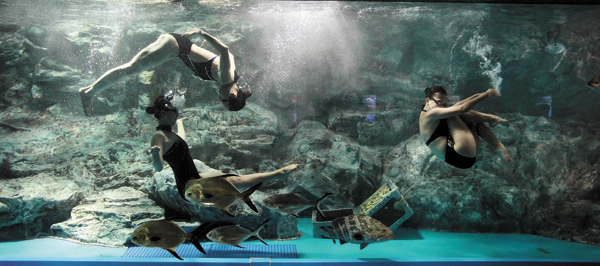Hanwha mining marine life for Aqua Planet

Synchronized swimmers perform ballet routines in a water tank at 63 Seaworld in Yeouido, Seoul. Hanwha aims to create a cultural and exhibition complex by combining performing arts with the aquarium. [JoongAng Ilbo]
Hanwha Hotels & Resorts is expanding its aquarium business across the country with a total investment of 300 billion won ($257.7 million) this year.
It has already built the nation’s largest marine exhibit in the form of Aqua Planet Yeosu, which opened to the public on May 12 in tandem with the Expo 2012 Yeosu Korea.
The leading leisure industry company will trump that next month with another same-brand aquarium in Jeju that will rank as the largest in Asia, while also showcasing the island’s female divers, or haenyeo, with dance performances.
Hanwha will add two more in Ilsan, Gyeonggi, and Daegu at a later date, it said.
However, the group began expanding this side of its business by restoring the past reputation of 63 Seaworld, an aquarium it has been operating in the 63 Building in Yeouido, Seoul, since it acquired Korea Life Insurance in 2002.
63 Seaworld was built in 1985 but was later eclipsed in terms of size, popularity and profit by the Coex Aquarium in Gangnam, southern Seoul.
“We formed a task force team to benchmark overseas aquariums to find out how to make them fun,” said Yoo Duk-jong, a senior vice president at the group’s resort unit.
Hanwha took notes from Asahiyama Zoo in Hokkaido, Japan, especially its famous “moving exhibition,” which makes a point of trying to show animals in their natural habitat with as little interference from people as possible.
The Japanese zoo inspired Hanwha’s hugely popular Otter Exhibit at 63 Seaworld. Otters pass over viewers’ heads in a tunnel that passes through the water tank, allowing visitors to view them more closely.
Holes in the tank also allow people to feed the otters.
The aquarium also features synchronized swimming performances by former national team athletes.
Hanwha said adding fun elements like this drove up sales from 14 billion won in 2007 to 22 billion won last year.
While large aquariums have been popular overseas for many years, as recently as 2005 ago there were four in Korea.
At 3,500 tons by volume, Busan Aquarium ranked as the biggest, but this still paled in comparison to the 25,000-ton aquarium in Georgia, the United States, that holds the record as the world’s grandest.
“The initial investment is so high that businesses tend to avoid building them, but once finished, they only require basic maintenance costs,” Yoo said.
Hanwha made the aquarium business a new growth engine in 2008.
It mapped out a blueprint with an aim of creating a cultural complex where visitors could watch exhibitions while also enjoying cultural activities.
Aqua Planet stands as the first realization of the blueprint, backing up comments by Hanwha Chairman Kim Seung-youn four years ago - when the group was selected to participate in the expo - that the group would use the expo to demonstrate what it could “contribute to national interest.”
Aqua Planet Jeju, which is slated to open in July, measures 10,800 tons, surpassing the 10,500-ton Churaumi Aquarium in Okinawa.
The main water tank at the Jeju facility measures 6,000 tons and takes two weeks to fill up.
The Ilsan facility is due to be finished next year as a combination of a zoo and an aquarium with a jungle-like venue.
Yoo said the group was making the animals’ welfare a top priority rather than just chasing profit.
By Han Eun-wha, Song Su-hyun [ssh@joongang.co.kr]










with the Korea JoongAng Daily
To write comments, please log in to one of the accounts.
Standards Board Policy (0/250자)